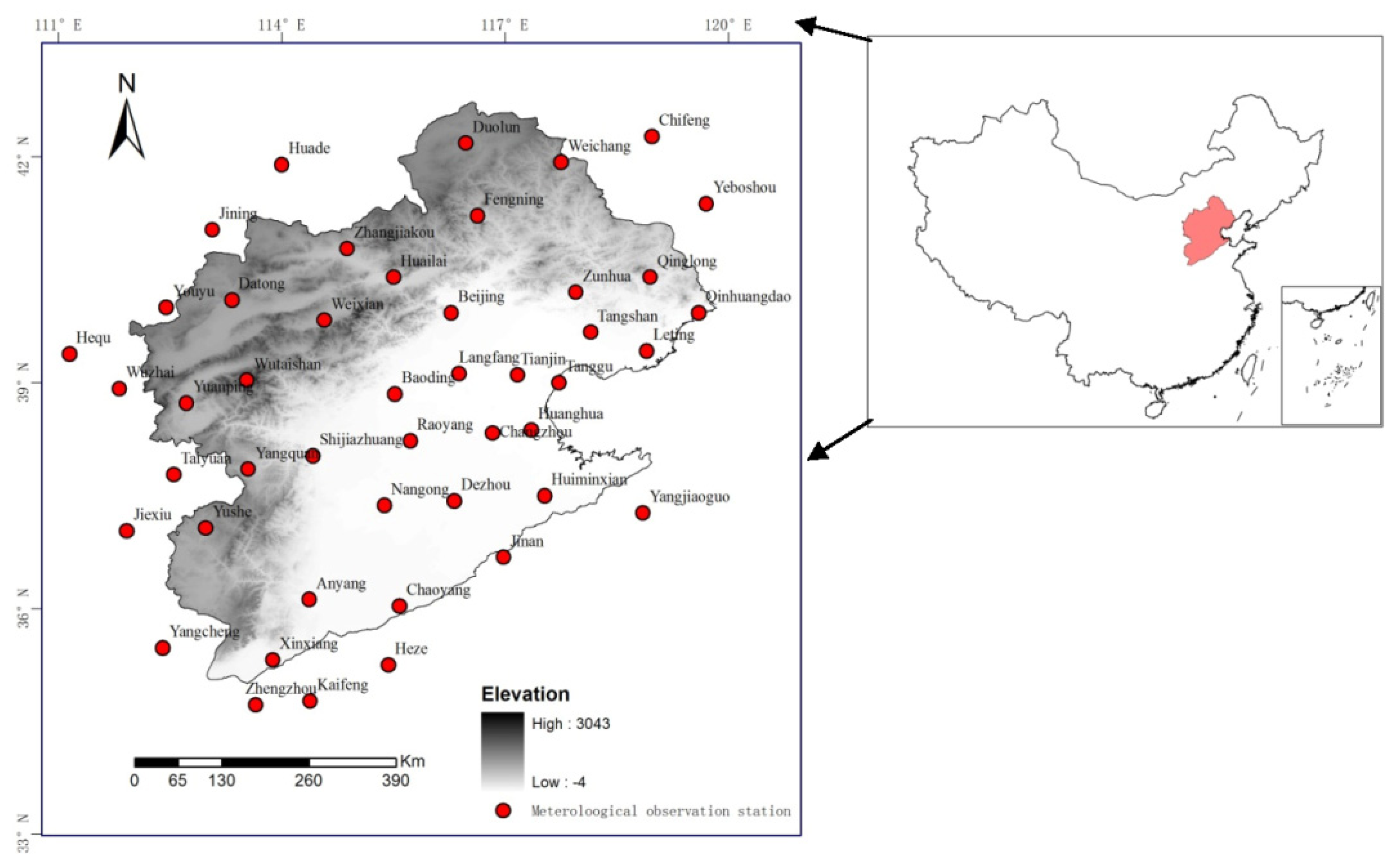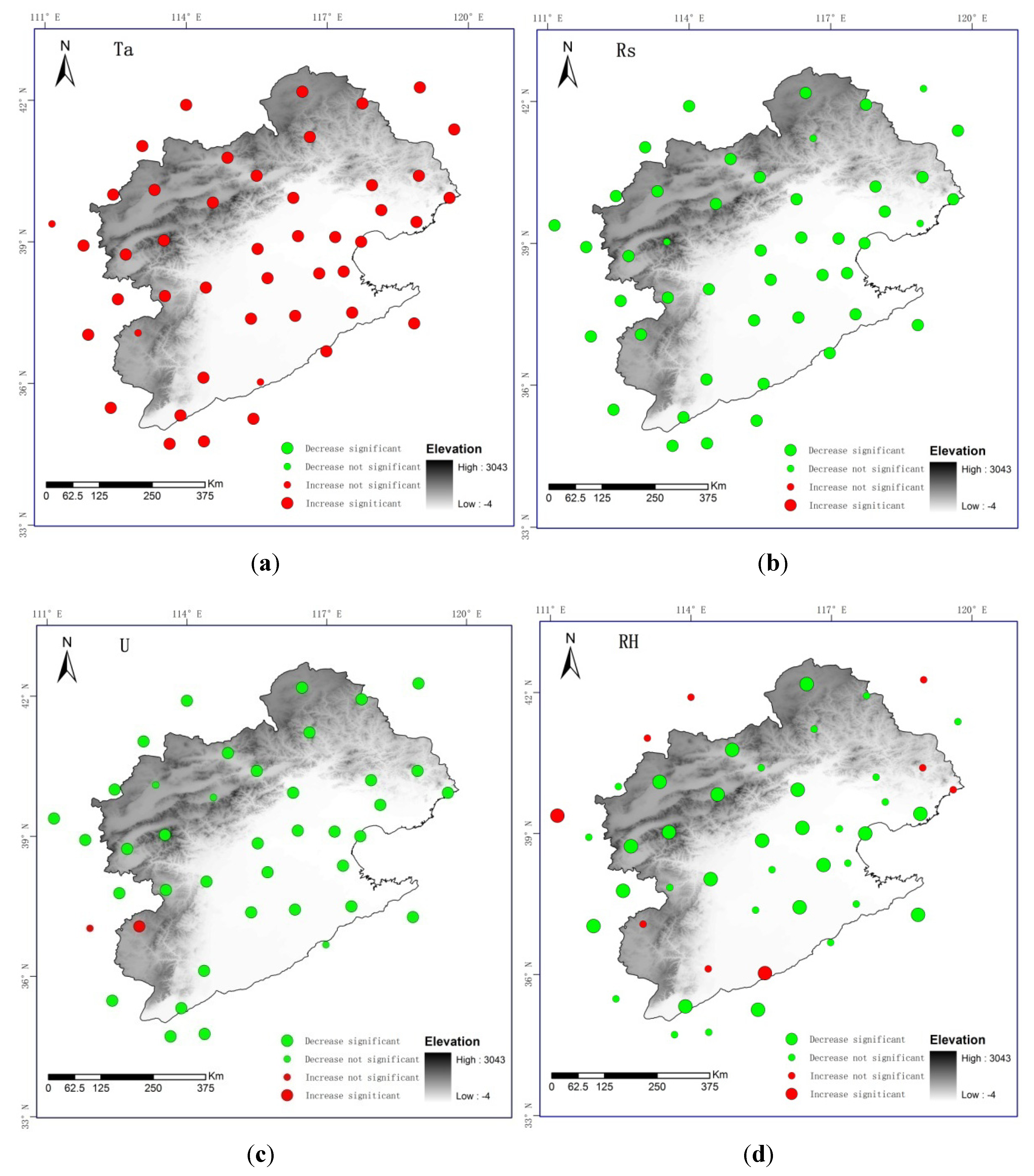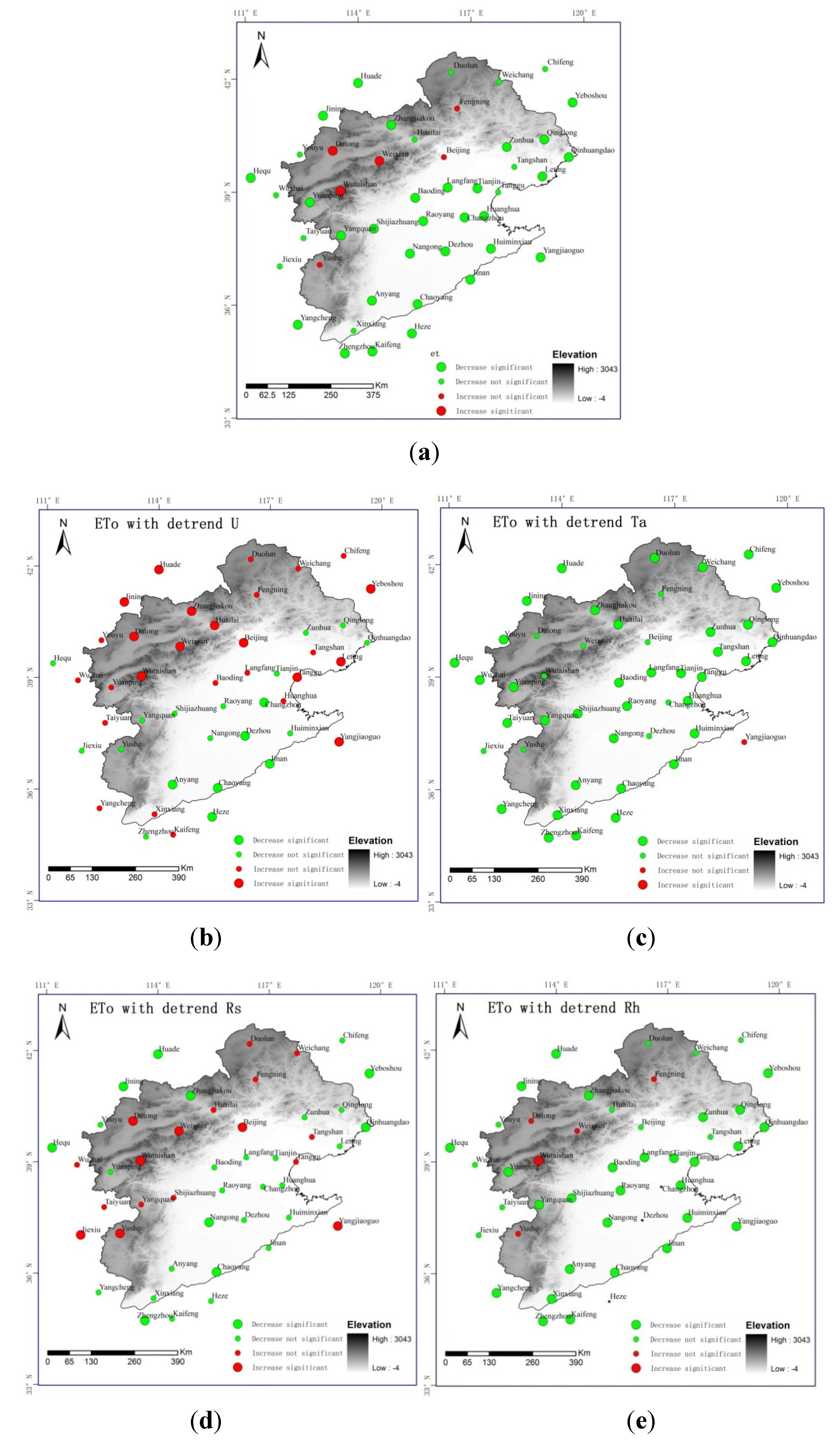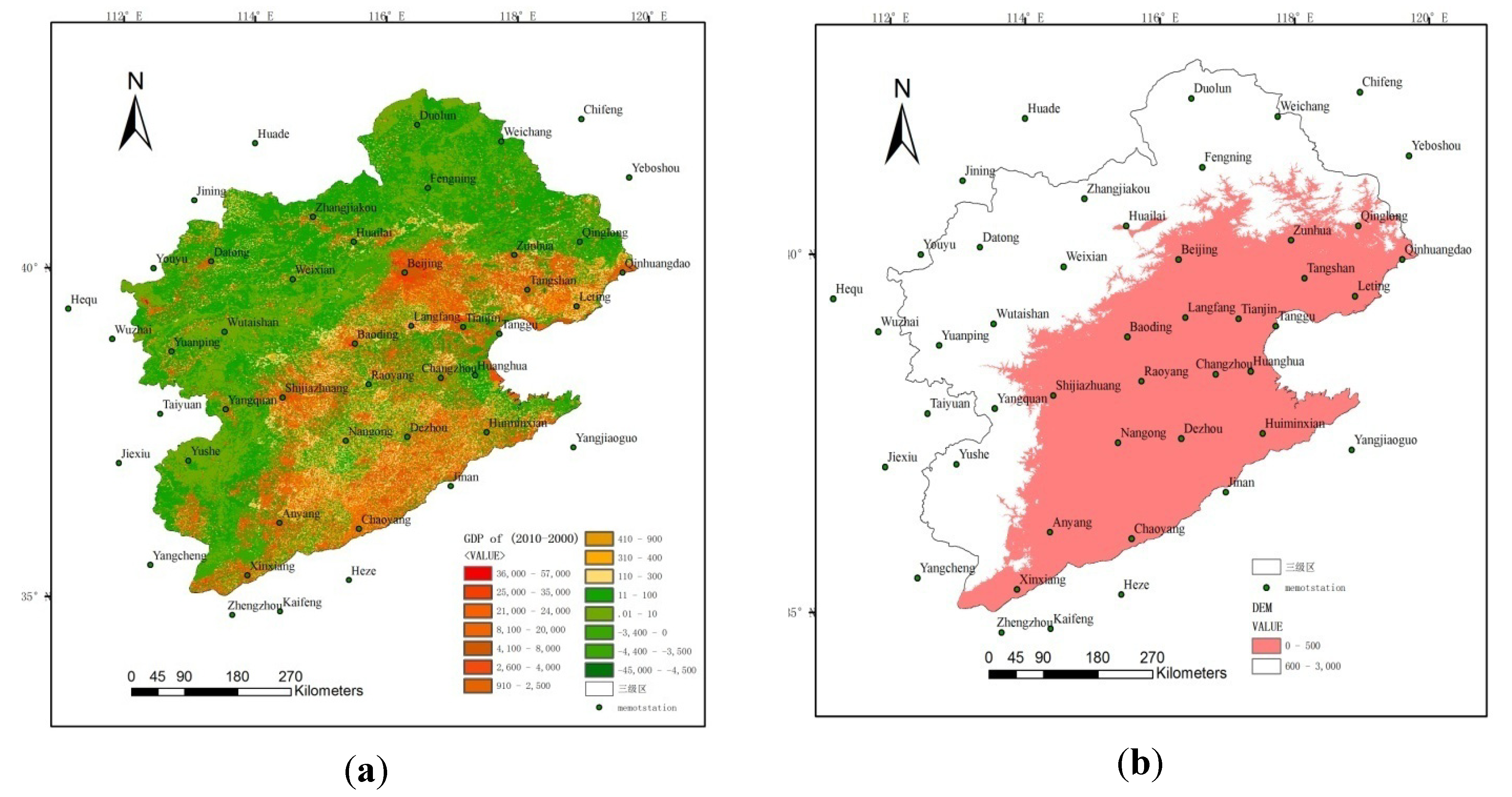Climatic Characteristics of Reference Evapotranspiration in the Hai River Basin and Their Attribution
Abstract
:1. Introduction
2. Study Area and Data

| Name | No. | Longitude (°) | Latitude (°) | Elevation (m) | Name | No. | Longitude (°) | Latitude (°) | Elevation (m) |
|---|---|---|---|---|---|---|---|---|---|
| Wutaishan | 53588 | 113.53 | 39.03 | 2896 | Changzhou | 54616 | 116.83 | 38.33 | 10 |
| Weixian | 53593 | 114.57 | 39.83 | 910 | Tanggu | 54623 | 117.72 | 39.00 | 3 |
| Yuanping | 53673 | 112.72 | 38.73 | 828 | Huanghua | 54624 | 117.35 | 38.37 | 7 |
| Shijiazhuang | 53698 | 114.42 | 38.03 | 81 | Nangong | 54705 | 115.38 | 37.37 | 27 |
| Yangquan | 53782 | 113.55 | 37.85 | 742 | Dezhou | 54714 | 116.32 | 37.43 | 21 |
| Yushe | 53787 | 112.98 | 37.07 | 1041 | Huiminxian | 54725 | 117.53 | 37.50 | 12 |
| Anyang | 53898 | 114.37 | 36.12 | 76 | Chaoyang | 54808 | 115.58 | 36.03 | 43 |
| Xinxiang | 53986 | 113.88 | 35.32 | 73 | Huade | 53391 | 114.00 | 41.90 | 1483 |
| Duolun | 54208 | 116.47 | 42.18 | 1245 | Shiyu | 53478 | 112.45 | 40.00 | 1346 |
| Fengning | 54308 | 116.63 | 41.22 | 660 | Jiying | 53480 | 113.07 | 41.03 | 1419 |
| Weichang | 54311 | 117.75 | 41.93 | 843 | Hequ | 53564 | 111.15 | 39.38 | 862 |
| Zhuangjiakou | 54401 | 114.88 | 40.78 | 724 | Wuzhai | 53663 | 111.82 | 38.92 | 1401 |
| Huailai | 54405 | 115.50 | 40.40 | 537 | Taiyuan | 53772 | 112.55 | 37.78 | 778 |
| Zunhua | 54429 | 117.95 | 40.20 | 55 | Jiexiu | 53863 | 111.92 | 37.03 | 744 |
| Qinglong | 54436 | 118.95 | 40.40 | 227 | Yangcheng | 53975 | 112.40 | 35.48 | 660 |
| Qinhuangdao | 54449 | 119.60 | 39.93 | 2 | Chifeng | 54218 | 118.97 | 42.27 | 568 |
| Beijing | 54511 | 116.28 | 39.93 | 54 | Yeboshou | 54326 | 119.70 | 41.38 | 662 |
| Langfang | 54518 | 116.38 | 39.12 | 9 | Yangjiaogou | 54736 | 118.85 | 37.27 | 6 |
| Tianjin | 54527 | 117.17 | 39.10 | 3 | Jinan | 54823 | 116.98 | 36.68 | 52 |
| Tangshan | 54534 | 118.15 | 39.67 | 28 | Heze | 54906 | 115.43 | 35.25 | 50 |
| Leting | 54539 | 118.90 | 39.42 | 11 | Zhengzhou | 57083 | 113.65 | 34.72 | 110 |
| Baoding | 54602 | 115.52 | 38.85 | 17 | Kaifeng | 57091 | 114.38 | 34.77 | 73 |
| Raoyang | 54606 | 115.73 | 38.23 | 19 | Datong | 53487 | 113.33 | 40.10 | 1067 |
3. Methodologies
3.1. Penman–Monteith Method

3.2. Trend Detection and Sensitivity Analysis Method





3.3. Spatial Correlation Coefficient


3.4. Detrend Method
4. Results and Discussion
4.1. Correlation between ETo and Epan

4.2. Spatial-Temporal Variation of ETo in HRB

4.3. Variation Pattern of Climatic Variables


| Station name | Ta | U | Rh | Rs |
|---|---|---|---|---|
| Datong | 4.78 | −1.55 | −1.81 | −2.54 |
| Wutaishan | 4.30 | −5.21 | −3.57 | −0.54 |
| Weixian | 4.87 | −0.92 | −3.07 | −2.04 |
| Mean value of the HRB | 4.16 | −4.12 | −1.41 | −3.94 |
4.4. Sensitivity of Climatic Variables

4.5. ETo with Detrend Climatic Variables

4.6. Relationship between ETo and Human Activity

| Elevation | Rs | Tmax | Tmin | Rh | U |
|---|---|---|---|---|---|
| >500 m a.s.l. | −3.689 | 3.698 | 4.727 | −1.157 | −3.773 |
| <500 m a.s.l. | −4.601 | 2.170 | 5.198 | −1.348 | −4.739 |
| Rs | U | Ta | Rh | Population | Elevation |
|---|---|---|---|---|---|
| 0.749 | 0.416 | 0.668 | −0.267 | −0.132 | 0.667 |
5. Conclusions
- (1)
- Most stations in the HRB have decreasing trends in the annual ETo at a confidence level of 95%. These stations are distributed mainly in the southern and eastern coastal areas of HRB. Three stations (Datong, Wutaishan and Weixian) in the western area of HRB show significant increasing trends in the annual ETo. As for the seasonal changes, similar characteristics with respect to the annual ETo were identified only in summer, while during the other three seasons (spring, autumn and winter), the trends were less obvious.
- (2)
- The spatial patterns of the Mann–Kendall trends of the annual meteorological variables show that the maximum and minimum temperatures increase significantly at the 0.05 significance level. However, the increase of the minimum temperature is more apparent than that of the maximum ones all over the basin. Wind speed and shortwave radiation show decreasing trends in the whole basin, and the trends are significant in the eastern and southern parts of the HRB. The sensitivity analysis shows that relativity humidity is the most sensitive variable to ETo, followed by temperature, shortwave radiation and wind speed as the least sensitive to ETo in the whole HRB.
- (3)
- Comprehensively considering the sensitivity and variation strength of the meteorological variables, the detrend analysis indicates the decreasing trends in ETo dominant in the eastern and southern area of HRB. These may be caused mainly by the behavior of wind speed and shortwave radiation. Meanwhile, the obtained detrend results suggest that the increasing temperature is the main cause of the increasing trend of ETo in Datong, Wutaishan and Weixian stations.
- (4)
- The spatial correlation coefficient between population and the trend of ETo is −0.132, and the correlation coefficient between the trend of ETo and natural factors is even higher. This suggests that human activity has a certain influence on the spatial variation of ETo, while natural factors play a decisive role in the spatial variation character of reference evapotranspiration in this area.
Acknowledgments
Author Contributions
Conflicts of Interest
References
- Okechukwu, A.; Luc, D.; Souley, Y.K.; le, B.E.; Ibrahim, M.; Abdou, A.; Théo, V.; Bader, J.; Moussa, I.B.; Gautier, E.; et al. Increasing river flows in the Sahel? Water 2010, 2, 170–199. [Google Scholar] [CrossRef]
- Huntington, T.G. Evidence for intensification of the global water cycle: Review and synthesis. J. Hydrol. 2006, 319, 83–95. [Google Scholar] [CrossRef]
- Changchun, X.; Yaning, C.; Yuhui, Y.; Hao, X.M.; Shen, Y.P. Hydrology and water resources variation and its response to regional climate change in Xinjiang. J. Geogr. Sci. 2010, 20, 599–612. [Google Scholar] [CrossRef]
- Zhao, L.L.; Xia, J.; Xu, C.Y.; Wang, Z.G.; Sobkowiak, L.; Long, C. Evapotranspiration estimated methods in hydrological simulation. J. Geogr. Sci. 2013, 23, 359–369. [Google Scholar] [CrossRef]
- Feddes, R.A.; Kowalik, P.J.; Zaradny, H. Simulation of Field Water Use and Crop Yield; Centre for Agricultural Publishing and Documentation: Wageningen, Netherlands, 1978. [Google Scholar]
- Ritchie, J.T. Model for predicting evaporation from a row crop with incomplete cover. Water Resourc. Res. 1972, 8, 1204–1213. [Google Scholar] [CrossRef]
- Bo, T.; Ling, T.; Shaozhong, K.; Lu, Z. Impacts of climate variability on reference evapotranspiration over 58 years in the Haihe river basin of North China. Agric. Water Manag. 2011, 98, 1660–1670. [Google Scholar] [CrossRef]
- Jun, X.; Huali, F.; Chesheng, Z.; Cunwen, N. Determination of a reasonable percentage for ecological water-use in the Haihe River Basin, China. Pedosphere 2006, 16, 33–42. [Google Scholar] [CrossRef]
- Zheng, H.X.; Liu, X.M.; Liu, C.M.; Dai, X.Q.; Zhu, R.R. Assessing contributions to panevaporation trends in Haihe River Basin, China. J. Geophys. Res. Atmos. 2009, 114. [Google Scholar] [CrossRef]
- Xu, C.Y.; Gong, L.B.; Jiang, T.; Chen, D.L. Decreasing reference evapotranspiration in a warming climatea case of Changjiang (Yangtze) River catchment during 1970–2000. Adv. Atmos. Sci. 2006, 23, 513–520. [Google Scholar] [CrossRef]
- Liu, B.H.; Xu, M.; Henderson, M.; Gong, W.G. A spatial analysis of pan evaporation trends in China, 1955–2000. J. Geophys. Res. 2004, 109. [Google Scholar] [CrossRef]
- Bormann, H. Sensitivity analysis of 18 different potential evapotranspiration models to observed climatic change at German climate stations. Clim. Chang. 2011, 104, 729–753. [Google Scholar] [CrossRef]
- Coleman, G.; DeCoursey, D.G. Sensitivity and model variance analysis applied to some evaporation and evapotranspiration models. Water Resourc. Res. 1976, 12, 873–879. [Google Scholar] [CrossRef]
- Gao, G.; Chen, D.L.; Ren, G.Y.; Chen, Y.; Liao, Y.M. Spatial and temporal variations and controlling factors of potential evapotranspiration in China: 1956–2000. J. Geogr. Sci. 2006, 16, 3–12. [Google Scholar] [CrossRef]
- Gong, L.B.; Xu, C.Y.; Chen, D.L.; Halldin, S.; Chen, Y.Q. David. Sensitivity of the Penman–Monteith reference evapotranspiration to key climatic variables in the Changjiang (Yangtze River) basin. J. Hydrol. 2006, 329, 620–629. [Google Scholar] [CrossRef]
- Goyal, R.K. Sensitivity of evapotranspiration to global warming: A case study of arid zone of Rajasthan (India). Agric. Water Manag. 2004, 69, 1–11. [Google Scholar] [CrossRef]
- Hupet, F.; Vanclooster, M. Effect of the sampling frequency of meteorological variables on the estimation of the reference evapotranspiration. J. Hydrol. 2001, 243, 192–204. [Google Scholar] [CrossRef]
- McCuen, R.H. A sensitivity and error analysis of procedures used for estimating evaporation1. JAWRA J. Am. Water Resourc. Assoc. 1974, 10, 486–497. [Google Scholar] [CrossRef]
- Allen, R.G.; Pereira, L.S.; Raes, D.; Smith, M. Crop Evapotranspiration-Guidelines for Computing Crop Water Requirements-FAO Irrigation and Drainage Paper 56; Food and Agriculture Organization: Rome, Italy, 1998; pp. 1–15. [Google Scholar]
- Kendall, M.G. Rank Correlation Measures; Charles Griffin: London, UK, 1975; Volume 202. [Google Scholar]
- Mann, H.B. Nonparametric tests against trend. Econ.: J. Econ. Soc. 1945, 13, 245–259. [Google Scholar]
- Xu, C.Y.; Gong, L.B.; Jiang, T.; Chen, D.L.; Singh, V.P. Analysis of spatial distribution and temporal trend of reference evapotranspiration and pan evaporation in Changjiang (Yangtze River) catchment. J. Hydrol. 2006, 327, 81–93. [Google Scholar] [CrossRef]
- Chong, S.Z. The Probabilistic Approach in Water Science and Technology; Science Press: Beijing, China, 2010. (In Chinese) [Google Scholar]
- Brutsaert, W. Land-surface water vapor and sensible heat flux: Spatial variability, homogeneity, and measurement scale. Water Resourc. Res. 1998, 34, 2433–2442. [Google Scholar]
- Zhang, Y.Q.; Liu, C.M.; Tang, Y.H.; Yang, Y.H. Trends in pan evaporation and reference and actual evapotranspiration across the Tibetan Plateau. J. Geophys. Res. Atmos. 2007, 112. [Google Scholar] [CrossRef]
- Liu, C.M.; Liu, X.M.; Zheng, H.X.; Zeng, Y. Change of the solar radiation and its causes in the Haihe River Basin and surrounding areas. J. Geogr. Sci. 2010, 20, 569–580. [Google Scholar] [CrossRef]
- Grimenes, A.A.; Thue-Hansen, V. The reduction of global radiation in south-eastern Norway during the last 50 years. Theor. Appl. Climatol. 2006, 85, 37–40. [Google Scholar] [CrossRef]
- Qian, Y.; Kaiser, D.P.; Leung, L.R.; Xu, M. More frequent cloud-free sky and less surface solar radiation in China from 1955 to 2000. Geophys. Res. Lett. 2006, 33. [Google Scholar] [CrossRef]
- Qian, Y.; Wang, W.G.; Leung, L.R.; Kaiser, D.P. Variability of solar radiation under cloud-free skies in China: The role of aerosols. Geophys. Res. Lett. 2007, 34. [Google Scholar] [CrossRef]
- Jiang, Y.; Luo, Y.; Zhao, Z.C.; Tao, S.W. Changes in wind speed over China during 1956–2004. Theor. Appl. Climatol. 2010, 99, 421–430. [Google Scholar] [CrossRef]
© 2014 by the authors; licensee MDPI, Basel, Switzerland. This article is an open access article distributed under the terms and conditions of the Creative Commons Attribution license (http://creativecommons.org/licenses/by/3.0/).
Share and Cite
Zhao, L.; Xia, J.; Sobkowiak, L.; Li, Z. Climatic Characteristics of Reference Evapotranspiration in the Hai River Basin and Their Attribution. Water 2014, 6, 1482-1499. https://doi.org/10.3390/w6061482
Zhao L, Xia J, Sobkowiak L, Li Z. Climatic Characteristics of Reference Evapotranspiration in the Hai River Basin and Their Attribution. Water. 2014; 6(6):1482-1499. https://doi.org/10.3390/w6061482
Chicago/Turabian StyleZhao, Lingling, Jun Xia, Leszek Sobkowiak, and Zongli Li. 2014. "Climatic Characteristics of Reference Evapotranspiration in the Hai River Basin and Their Attribution" Water 6, no. 6: 1482-1499. https://doi.org/10.3390/w6061482
APA StyleZhao, L., Xia, J., Sobkowiak, L., & Li, Z. (2014). Climatic Characteristics of Reference Evapotranspiration in the Hai River Basin and Their Attribution. Water, 6(6), 1482-1499. https://doi.org/10.3390/w6061482






